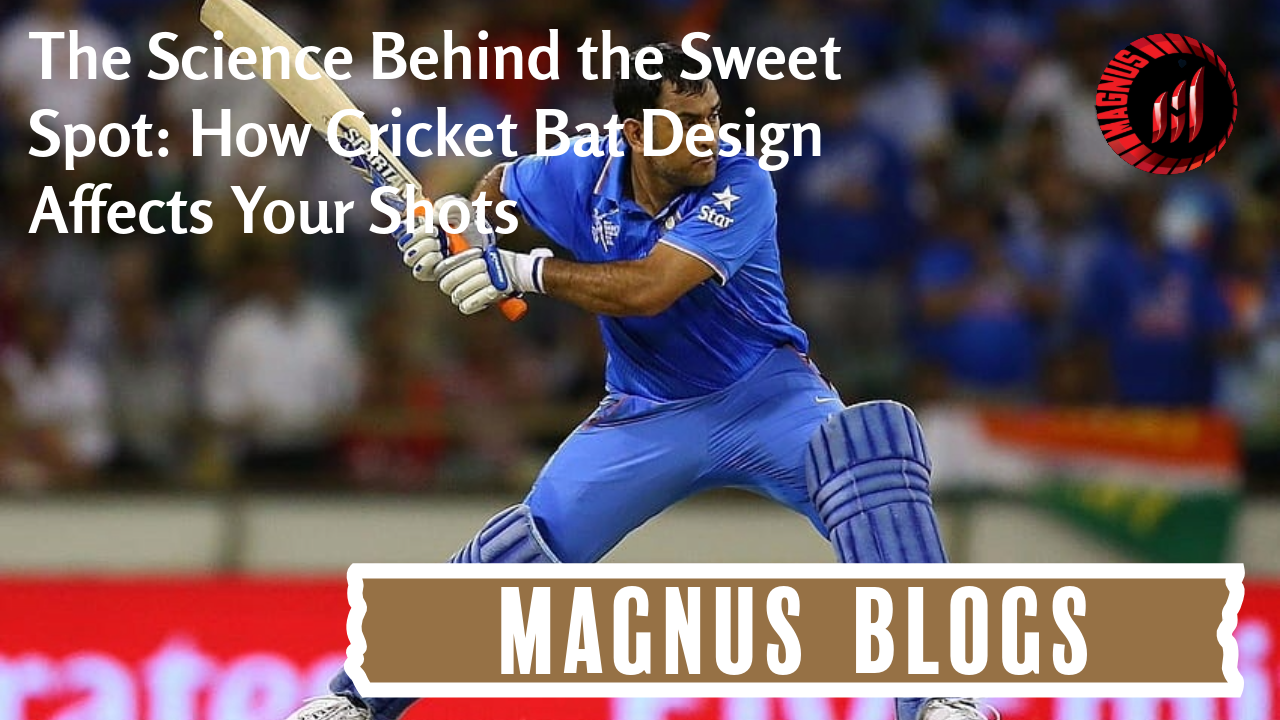Cricket is a game of precision, technique, and timing. One of the most critical factors in batting success is the sweet spot of a cricket bat—the area that delivers maximum power and control when striking the ball. But what exactly determines the sweet spot, and how does bat design influence a player's performance?
In this blog, we will explore the physics behind the sweet spot, the impact of bat materials, mass distribution, and modern technology in cricket bat design. Understanding these factors can help players make better bat choices and improve their batting skills.

What is the Sweet Spot on a Cricket Bat?
The sweet spot is the area on the bat’s face where energy transfer is most efficient when striking the ball. Hitting the ball on this part of the bat results in:
-
Maximum power with minimal effort.
-
Less vibration felt in the hands.
-
Better shot control and timing.
If the ball strikes outside the sweet spot, energy is lost, reducing shot power and increasing vibrations in the handle, which can make the shot feel uncomfortable or mis-hit.

The Science of Energy Transfer in Cricket Bats
When the ball contacts the bat, energy from the ball is transferred into the bat. The location and size of the sweet spot depend on:
-
Mass Distribution
-
Heavier bats generate more power but require more strength to control.
-
Lighter bats allow for quicker reactions and flexibility but might lack power.
-
-
Willow Quality & Density
-
English Willow is softer, absorbs impact better, and has a more responsive sweet spot.
-
Kashmir Willow is harder, durable, but less forgiving when mistimed.
-
-
Bat Profile & Shape
-
Different bat profiles (high, mid, or low sweet spot) affect how a player plays different types of shots.
-
-
Moment of Inertia (MOI)
-
Bats with a higher MOI (mass distributed toward the toe) generate more powerful strokes but may be harder to control.
-
Lower MOI (mass distributed towards the handle) provides better bat speed for quick reactions.
-

Types of Sweet Spot Positions & Their Impact on Batting
1. Low Sweet Spot (Ideal for Front-Foot Play & Slow Pitches)
-
Found in bats with more wood concentrated toward the toe.
-
Ideal for players who prefer playing drives and sweep shots.
-
Best for low-bouncing pitches (e.g., subcontinent conditions).
-
Example: SS Vintage 9000, MRF Genius Grand Edition.

2. Mid Sweet Spot (Balanced Power & Control)
-
The most versatile sweet spot location, suitable for both front-foot and back-foot play.
-
Helps generate power without sacrificing control.
-
Ideal for all formats, including Test, ODI, and T20 cricket.
-
Example: Gray-Nicolls Legend, GM Noir.

3. High Sweet Spot (Best for Back-Foot Play & Fast Bouncy Pitches)
-
Found in bats with a higher concentration of mass toward the shoulders.
-
Great for back-foot shots like cuts, pulls, and hooks.
-
Ideal for bouncy tracks (e.g., Australia, South Africa, England).
-
Example: Kookaburra Ghost, Spartan MSD.
How Bat Shape & Profile Influence the Sweet Spot
1. Thick Edges & Power Profiles (Modern T20 Bats)
-
Bats with thicker edges and larger sweet spots are designed for power hitting.
-
They allow players to clear boundaries even with off-center hits.
-
Example: SS Sky 360, SG Sunny Tonny.

2. Traditional Thin Blade Bats (Classic Test Bats)
-
More control and timing over raw power.
-
Best for batsmen who rely on placement and technique rather than brute force.
-
Example: New Balance DC, Gunn & Moore Diamond.
The Role of Bat Handle & Grip in Shot Power
1. Handle Type:
-
Short Handle – Best for players under 6 feet, offering better control.
-
Long Handle – Provides more reach and leverage but requires extra strength.
2. Grip Thickness:
-
A thicker grip absorbs more shock and reduces vibrations.
-
Players can customize grip layers to suit their comfort.
How Modern Technology is Changing Cricket Bat Design
1. Smart Bats with Sensors
-
Embedded technology in bats (such as BatSense by Spektacom) helps analyze shot impact, bat speed, and technique in real-time.
2. Computer-Aided Design (CAD) in Bat Manufacturing
-
Brands use 3D modeling software to optimize bat weight distribution for better sweet spots.
3. Composite & Hybrid Cricket Bats
-
New materials like carbon fiber reinforcements improve bat strength without increasing weight.

Choosing the Right Bat for Your Playing Style
For Aggressive T20 Hitters:
-
Choose a bat with a low or mid sweet spot and thick edges.
-
Example: MRF VK18, SS Sky 360, SG Players Edition.
For Classical Test Batsmen:
-
Opt for a bat with a high sweet spot and traditional blade shape.
-
Example: Gray-Nicolls Legend, New Balance DC.
For All-Rounders:
-
A balanced bat with a mid sweet spot works best.
-
Example: GM Noir, Kookaburra Kahuna.
Cricket bat types, Cricket equipment in usa, Cricket equipment store, Cricket gloves, Cricket helmet, Cricket kit bags, Cricket retailers, Durable cricket gloves, English willow bats, Icc approved helmets., Kashmir willow cricket bat, Latest kashmir willow bat
